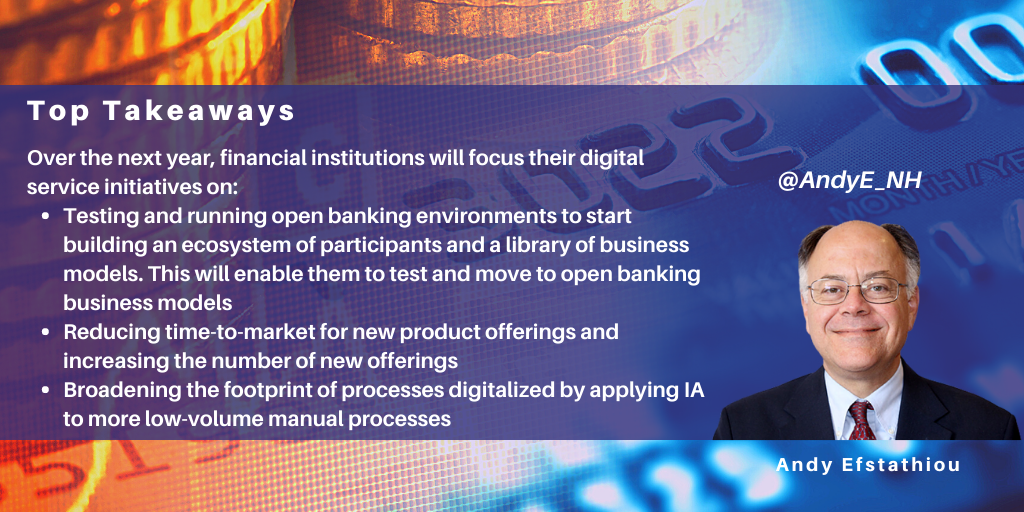posted on Feb 23, 2022 by Andy Efstathiou

In NelsonHall’s newly published market assessment, Digital Banking Services: Transforming the Financial Services Industry, we found that financial institutions are changing their approach to digital services: from a focus on digital channels and CX to a focus on rapid solution development, cloud migration, data management, and STP.
The goal for financial institutions today is to be able to rapidly iterate new business models in an open banking environment. The pace of industry change is increasing, while labor-based operations are slowing financial institutions’ abilities to respond. The pandemic has accelerated the pace and scope of change as all business functions have had to move to remote delivery.
The state of digital services in banking
For the past year, financial institutions have been:
- Expanding the use of automated software development tools, low-code/no-code techniques, and APIs to enable platform modularization, new functionality, and the move to the cloud
- Standardizing data management and orchestration across silos
- Accelerating the use of cloud delivery and BPaaS.
Over the next year, financial institutions will focus on:
- Testing and running open banking environments to start building an ecosystem of participants and a library of business models
- Increasing their focus on human/bot teams and their effectiveness
- Reducing time-to-market for new product offerings and increasing the number of new offerings
- Applying intelligent automation to more low-volume manual processes.
However, the external environment has put up barriers to transformation. The key barriers impeding the efforts of financial institutions include:
- Opening the core platform to external parties: open banking and new stakeholders requires development of APIs and plugins for legacy platforms to increase interoperability
- Enabling new digital business models: increasing platform agility and new functionality to support new businesses
- Building and enabling partnerships: sourcing IP from open source, acquisition, or shared products
- Working with new markets and products: different markets and products have different cost structures. Banks are shifting to high-volume/low-margin products (e.g., customers: mass affluent and unbanked; products: self-service and robot-advised). These offerings require high automation, embedded AI, multi-channel access, and high compliance capabilities, each adapted to multiple, unique markets.
Rising to the challenge
To address these challenges successfully, financial institutions need to focus on two activities: strategy and execution.
Key factors in strategy include:
- Changing the business model: banks need to reduce fixed costs and be able to scale volumes at a constant margin to be able to rapidly change business models across time and markets
- Developing a roadmap to achieve agile/flexible operations delivery using cloud/BPS/heterogenous delivery
- Building an ecosystem of operations vendors with domain knowledge and experience with clients’ operations environment, vendors with complementary digital skills to deliver services, and the ability to work within client operational practices and transfer knowledge.
Key factors in execution include:
- Working with hyperscalers: migrating internal operations by standardization, consolidation, and modularization of platforms
- Redefining the external/internal operations split (with the rollout based on tested use cases):
- External processes: high value, non-repetitive, cyclical processes
- Internal processes: lower value/less differentiation/less volatile
- Selecting emerging product vendors for functionality, roadmap, financial strength, and the product vendor ecosystem. Preferred vendors should have the widest pool of IT services providers supporting them
- Orchestration: selection and implementation of orchestration tools to manage a heterogeneous system of vendors and products.
In summary, financial institutions are changing their goals from improving process efficiency for static businesses to increasing operational agility to continuously changing business models and operations. The operational changes being made will drive business model change. And these operational changes will drive accelerating change in banks’ product offerings, customer base, and market presence.
Find out more about NelsonHall’s “Digital Banking Services: Transforming the Financial Services Industry” market assessment and forecast report here or contact Guy Saunders.
